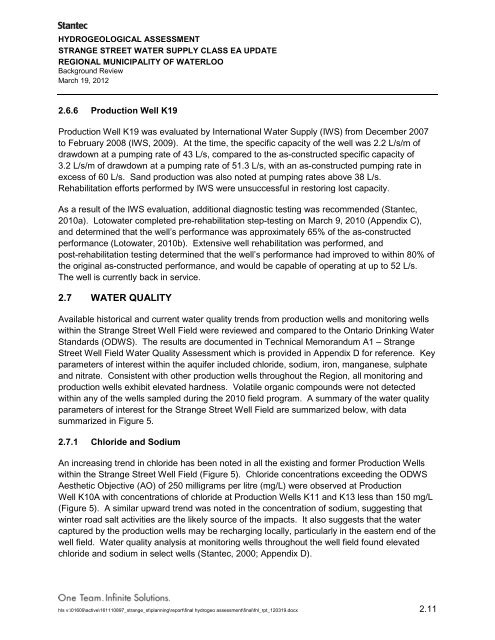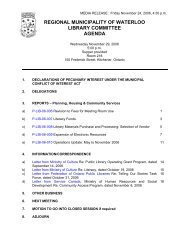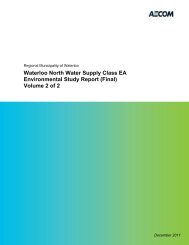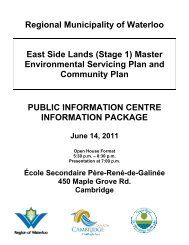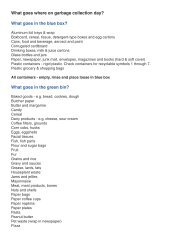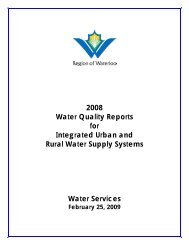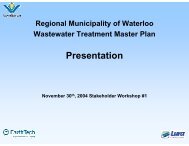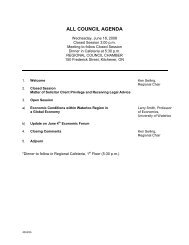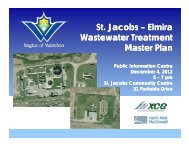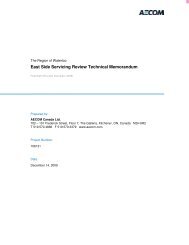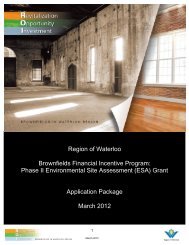Sam Ziemann From - Region of Waterloo
Sam Ziemann From - Region of Waterloo
Sam Ziemann From - Region of Waterloo
You also want an ePaper? Increase the reach of your titles
YUMPU automatically turns print PDFs into web optimized ePapers that Google loves.
HYDROGEOLOGICAL ASSESSMENTSTRANGE STREET WATER SUPPLY CLASS EA UPDATEREGIONAL MUNICIPALITY OF WATERLOOBackground ReviewMarch 19, 20122.6.6 Production Well K19Production Well K19 was evaluated by International Water Supply (IWS) from December 2007to February 2008 (IWS, 2009). At the time, the specific capacity <strong>of</strong> the well was 2.2 L/s/m <strong>of</strong>drawdown at a pumping rate <strong>of</strong> 43 L/s, compared to the as-constructed specific capacity <strong>of</strong>3.2 L/s/m <strong>of</strong> drawdown at a pumping rate <strong>of</strong> 51.3 L/s, with an as-constructed pumping rate inexcess <strong>of</strong> 60 L/s. Sand production was also noted at pumping rates above 38 L/s.Rehabilitation efforts performed by IWS were unsuccessful in restoring lost capacity.As a result <strong>of</strong> the IWS evaluation, additional diagnostic testing was recommended (Stantec,2010a). Lotowater completed pre-rehabilitation step-testing on March 9, 2010 (Appendix C),and determined that the well’s performance was approximately 65% <strong>of</strong> the as-constructedperformance (Lotowater, 2010b). Extensive well rehabilitation was performed, andpost-rehabilitation testing determined that the well’s performance had improved to within 80% <strong>of</strong>the original as-constructed performance, and would be capable <strong>of</strong> operating at up to 52 L/s.The well is currently back in service.2.7 WATER QUALITYAvailable historical and current water quality trends from production wells and monitoring wellswithin the Strange Street Well Field were reviewed and compared to the Ontario Drinking WaterStandards (ODWS). The results are documented in Technical Memorandum A1 – StrangeStreet Well Field Water Quality Assessment which is provided in Appendix D for reference. Keyparameters <strong>of</strong> interest within the aquifer included chloride, sodium, iron, manganese, sulphateand nitrate. Consistent with other production wells throughout the <strong>Region</strong>, all monitoring andproduction wells exhibit elevated hardness. Volatile organic compounds were not detectedwithin any <strong>of</strong> the wells sampled during the 2010 field program. A summary <strong>of</strong> the water qualityparameters <strong>of</strong> interest for the Strange Street Well Field are summarized below, with datasummarized in Figure 5.2.7.1 Chloride and SodiumAn increasing trend in chloride has been noted in all the existing and former Production Wellswithin the Strange Street Well Field (Figure 5). Chloride concentrations exceeding the ODWSAesthetic Objective (AO) <strong>of</strong> 250 milligrams per litre (mg/L) were observed at ProductionWell K10A with concentrations <strong>of</strong> chloride at Production Wells K11 and K13 less than 150 mg/L(Figure 5). A similar upward trend was noted in the concentration <strong>of</strong> sodium, suggesting thatwinter road salt activities are the likely source <strong>of</strong> the impacts. It also suggests that the watercaptured by the production wells may be recharging locally, particularly in the eastern end <strong>of</strong> thewell field. Water quality analysis at monitoring wells throughout the well field found elevatedchloride and sodium in select wells (Stantec, 2000; Appendix D).hls v:\01609\active\161110897_strange_st\planning\report\final hydrogeo assessment\final\fnl_rpt_120319.docx 2.11


